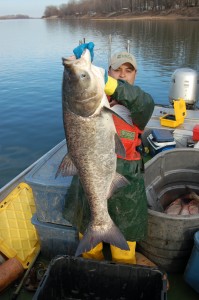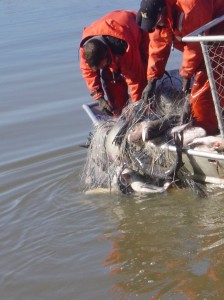Posted December 12, 2014
By LINDSAY THOMPSON
Imagine you are floating down the calm waters of the Illinois River, enjoying a beer with some friends while you cast out a line into the murky water. All of the sudden, your buddy is smacked in the face by a 50-pound silvery fish rocketing from the water.

A U.S. Geological Survey worker hold up a Bighead Carp, one of the species of Asian carp invading the Illinois waterways (Photos courtesy of the U.S. Geological Survey).
It was an Asian carp. These carp are not only a potential threat to boaters and swimmers, but to the Great Lakes’ ecosystem.
“The diet of Asian carp overlaps with the diet of native fishes in the Mississippi and Illinois Rivers, meaning the carp compete directly with native fish for food,” the Asian Carp Regional Coordinating Committee has written on its Web site.
According to Fisheries and Oceans Canada, “The most likely entry point into the Great Lakes basin is the Chicago Area Waterway System (CAWS) into Lake Michigan. The effectiveness of the electrical barrier in the Chicago Sanitary and Ship Canal (CSSC) was not evaluated.”
The native fish in the Illinois River and Mississippi River area are already struggling to compete with the Asian carp and, if the carp were to enter the Great Lakes, it would cause an even larger problem for native species.
The main way that the Asian carp are currently being kept out of the Great Lakes is through the use of electric dispersal barriers in the CSSC and CAWS, which are the only connections from the Mississippi River to Lake Michigan. Standard barriers and dams are not generally used since the carp can jump so high and could potentially sail over the top of one.
Click on the video above to view an audio slideshow about the Asian carp threat to the Great Lakes prepared by writer Lindsay Thompson.
The ACRCC explained how the electrical barriers work: “The barriers, located approximately 25 miles from Lake Michigan and within a 1,500-foot section of the CSSC, are formed of steel electrodes that are secured to the bottom of the CSSC. The electrodes are connected to a raceway, consisting of electrical connections to a control building. Equipment in the control building generates a DC pulse through the electrodes, creating an electric field in the water that discourages fish from crossing.”
However, as previously mentioned, the barriers are not necessarily 100 percent effective.
Kevin Irons, co-chair of the ACRCC Monitoring Workgroup, said it is going to continue to improve methods that have worked in the past, such as the Electric Dispersal Barriers.
“The 2014 Monitoring and Response Plan, continues to build off past efforts to protect the Great Lakes by using past data and results to focus attention on actions that achieve the greatest results,” said Irons.
Dr. Jim Garvey is the director of the Center for Fisheries, Aquaculture and Aquatic Sciences at Southern Illinois University, Carbondale, as well as a professor in the Zoology Department.
“My research group is among a large contingent of ecologists, engineers and water scientists trying to determine whether these species will enter the Great Lakes, explode in density and tank the multi-billion dollar fishing and recreational industry there,” he said.
Garvey is working to solve the Asian carp problem and keep them out of the Great Lakes system, even taking his research as far as traveling to the fishes native land of China, and figuring out how the people there have maintained the carp population.
One possible solution Garvey proposes to help to diminish the Asian carp population in U.S. Waterways is to start eating them.
The Chinese have been serving Asian carp for thousands of years.
“We Americans need to move past the stigma and eat these fish. They are invasive and damaging to the environment. So, not only are you getting a healthy meal, but you are doing the rivers and lakes of the U.S. and Canada a favor,” Garvey stated.
There are no fish native to North America that are large enough to become a predator to the Asian carp, so having humans become their main predator may actually be a good system for containing the population.
The Asian carp population may seem to be under control at the moment, but we do not know exactly how well the current measures will continue to work. It is only a matter of time before the carp infiltrate the Great Lakes and boaters, swimmers and native fish are each impacted.

